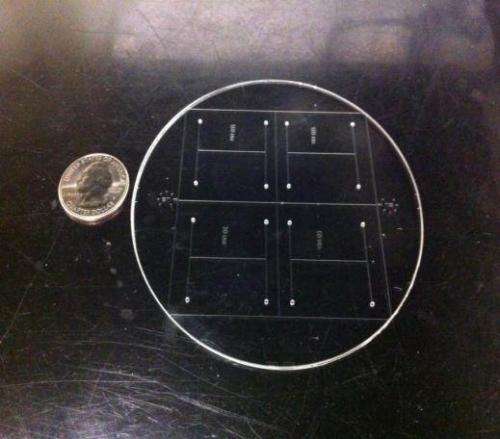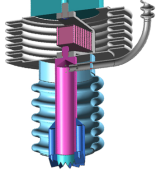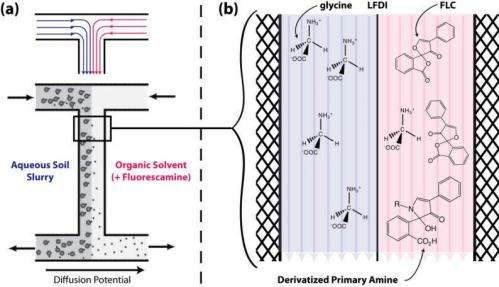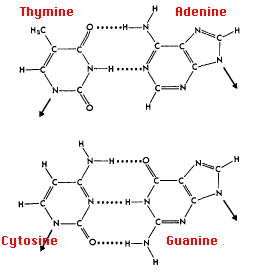This photograph shows some of the microchannels being tested by the AstroBioNibbler team for use in organic molecule extraction. Credit: Mike Lee, JPL
You might call it a high-tech panhandler, with its design for sifting through sprinkles of dirt to find tiny specks of organic material. Or you might think of it as a soil-eating-micro-espresso machine that could potentially brew up the smallest hints of martian life.
The instrument is dubbed AstroBioNibbler, or Nibbler for short. Its developers envision it as an end-to-end device (from drilling to extraction to final chemical analysis) that could ride shotgun on some forthcoming rover mission.
"Our intention is to bring traditional analytical chemistry tools to the search for life on Mars," says Frank Grunthaner an emeritus scientist from JPL who leads the AstroBioNibbler project.
Unlike current and past missions that bake samples in hot ovens to release gases, the Nibbler takes the "espresso approach," as Grunthaner likes to describe it. This involves dissolving out target molecules using super-heated water.
Liquid-based methods are far more sensitive than gas-based ones, Grunthaner says. The AstroBioNibbler team is promising a rover-compatible device that could detect a single amino acid in a gram (a mere nibble) of soil.
With funding from NASA's Astrobiology Science and Technology Instrument Development (ASTID) program, Grunthaner and his colleagues will be testing the components of this "espresso" mechanism, as well as miniaturizing the entire instrument so that it might fit easily on a future Mars mission.
Take a bite out of Mars
The Nibbler is a reincarnation of Urey, a previously proposed instrument for the European ExoMars mission. Urey was removed from that mission in 2009, in part, because it weighed too much, Grunthaner says. With a goal of 2.5 kilograms, the Nibbler should be roughly a quarter the weight of Urey.
Another difference with Urey is that the Nibbler is supposed to do its own sample collection, which reduces the possibility of cross-contamination with other instruments.
"It's an end-to-end analytical system, all without going through any shared hardware," Grunthaner says.
The Nibbler design includes a drill to dig into the martian soil. A vacuum system pulls up the resulting powder into a holding cell, where it is mixed with water and then passed to a microfluidic lab-on-a-chip. The use of liquid chemistry sets Nibbler apart from previous missions.
Design for the AstroBioNibbler's powder capture instrument. The drill at the bottom is connected to a vacuum system that sucks up samples for further analysis. Credit: Stewart Sherrit, JPL
The search for organic material on Mars began with the two Viking landers, which each carried a Gas Chromatograph-Mass Spectrometer (GC-MS) that heated soil samples to as high as 500 degrees Celsius in order to release vapors that could then be analyzed. The Viking mission was unable to detect any clear signature of martian organics. The only organic compounds it did recover were chlorinated methanes, which scientists at the time assumed came from residual cleaning products used on the spacecraft.
Viking was followed many years later by the Mars Phoenix mission, which detected a chlorine-containing molecule, called perchlorate, in its soil samples. Some researchers now suggest that perchlorate may have been responsible for destroying organics (through oxidation) in the Viking samples during the heating process, with the by-product being the observed chlorinated methane.
Currently, the hunt for organics is being carried out by the SAM instrument on board the Curiosity rover. It too uses a GC-MS that analyzes vapors from samples heated to high temperature. But it also has a low-temperature (less than 300 degrees Celsius) method of chemically extracting organic compounds that may avoid the perchlorate-oxidation problem.
Martian espresso
AstroBioNibbler also uses a relatively low-temperature technique to extract target molecules.
"Instead of heating the bejesus out of a sample and analyzing the gases, our approach is more classical," Grunthaner says.
This "classical" approach involves placing samples in a solution and then separating out the molecules of interest. On Earth, chemists typically use an acid, like hydrochloric acid, as their dissolving agent.
"But engineers have a dim view of carrying acids on a spacecraft, so we had to come up with a different technique." Grunthaner says.
The working concept for the AstroBioNibbler's organic molecule extraction. Water-soil mixture (left-side) flows in parallel with an organic solvent (right-side). Organic molecules in the soil diffuse across the flow boundary and into the organic solvent, where they are tagged by fluorescent markers. Credit: Andrew Aubrey and Frank Grunthaner, JPL
The Nibbler team has developed an extraction method using super-heated water, which is water that has been heated to around 180 degrees Celsius but is kept liquid by applying high pressure. Water in this state acts like a non-polar solvent that can dissolve out organics and other compounds of interest.
"It's like an espresso machine that extracts molecules from soil rather than coffee grains," Grunthaner explains.
VTo isolate the organic molecules from the rest of the water-soil mixture, the Nibbler instrument places the flow of the sample solution in parallel with a stream of organic solvent. Through simple diffusion, organic molecules "hop" to this second stream, where they are later collected and concentrated.
In order to detect the organics, the Nibbler will carry fluorescent markers that attach to specific organic molecular groups. Once tagged, the molecules enter a liquid chromatograph that identifies compounds by the rate at which they pass through specially designed columns.
Follow the nitrogen
In the wake of NASA's "follow the water" strategy, the AstroBioNibbler team has made "follow the nitrogen" their modus operandi. With its choice of fluorescent markers, the instrument will target nitrogen-bearing organics, which includes protein-forming amino acids and the nucleobases that make up the backbone of nucleic acids, such as DNA and RNA.
"Organic nitrogen compounds are central for biology as we know it," says Jeff Bada from the University of California, San Diego. "No other class of compounds plays a more important role."
The four nucleobases found in DNA pair up through nitrogen-mediated hydrogen bonds. Credit: J. Bada
Life on other planets may not use nitrogen (or organics for that matter), but nitrogen-bearing organics have such a rich, structural variety, that it's hard to picture life without them.
"Nitrogen atoms in nucleobases and amino acids form hydrogen bonds that stabilize the structure of both nucleic acids and proteins," Bada explains. "Without these hydrogen bonds there would be no helical structure to DNA and RNA and no alpha-helix structure for proteins."
Besides giving shape to biological molecules, the nitrogen-hydrogen bonds also allow for certain vital chemistry to occur (that's because these bonds are not so strong that they become too hard to break).
"No other atom than nitrogen can form the diverse set of hydrogen-bonded compounds found to be fundamental in the biologically central processes of replication and catalysis," Bada says.
Basic organic nitrogen compounds may have been abundant on early Earth and other planets, as evidenced by prebiotic simulations and meteorites. By looking for compounds that destroy organic molecules, such as transition metals, oxychlorides, peroxides and perchlorates, AstroBioNibbler could provide a final answer for why the Viking lander found no trace of organics on the martian surface.
"We need to know if these inorganic 'pathogens' are on the surface of Mars, attacking the organic compounds that we are chasing," Grunthaner says.
The Nibbler would use a different extraction scheme but a similar liquid chromatography method to identify any oxidizing compounds in the martian soil.
All of the chemical analysis (both for organics and inorganics) would take place on a tiny lab-on-a-chip. Unlike gas chromatographs that rely on mechanical valves to control the flow of sample vapors, the Nibbler would control its different fluid flows with electronic switches, thus taking full advantage of microelectronic manufacturing techniques.
Grunthaner says the project is making good in its first year (current funding is for four years). Some aspects, like sample recovery, are already well-established. But other parts, such as chemical extraction with super-heated water, will need more testing.
"At the end of this year, we will know all of the chemistry," Grunthaner says.
Source: Astrobio.net


























